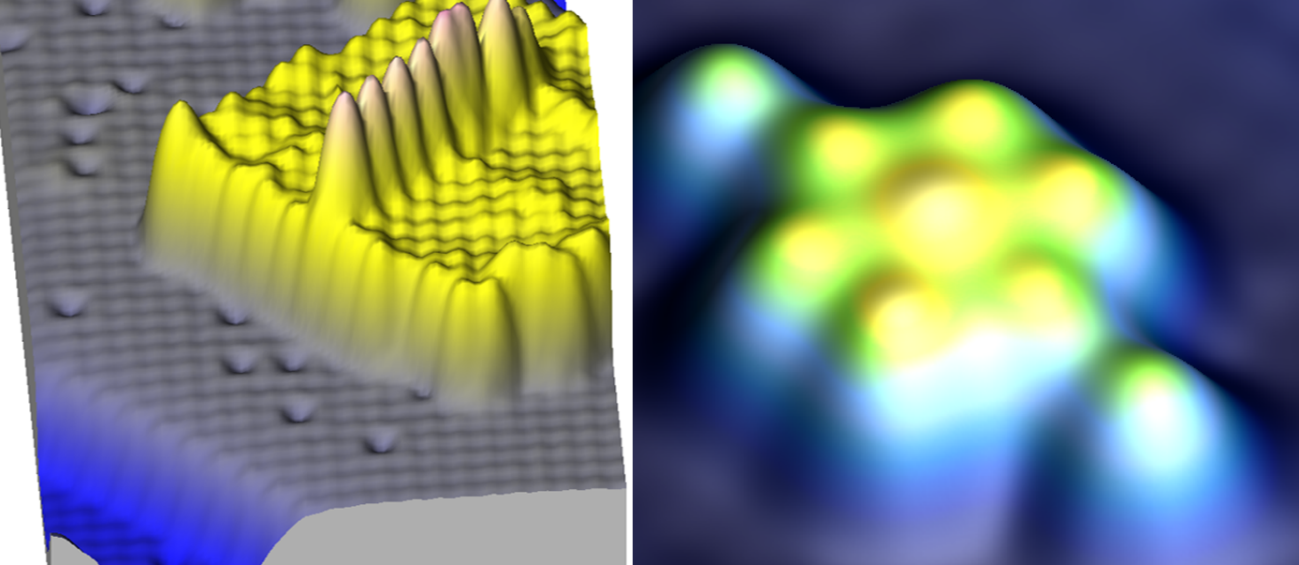Spin Quantum Properties
The use of quantum capacitors made of superconducting materials is generalized among the key actors in the race for quantum supremacy. In spite of that, the truth is that there is probably no better instrument for quantum information processing than a pure magnetic quantum number, as is the electronic or nuclear spin in the atom. Spin quantum bits are however still posing a number of unsolved drawbacks, like their sensitivity to the coupling with the environment that causes poor quantum coherence. In the SPM facilities at LMA we are exploring novel types of quantum spins that solve some of these drawbacks.
The low temperature microscopes of SPM area offer 0.1 meVenergy resolution complementary to the well-established spin resolved STM technique. This combination is ideal to investigate individual quantum spins or coupled spins in artificial atomic scale structures (we are still working in the implementation of the time domain in the JT-STM). Our main activity focuses on two types of spins: the ones arising from π-orbital magnetism in zig-zag segments of nanographenes, and the total electronic spin of 3d metals deposited on insulating surfaces, as the Co structures shown in the following image.

Left) Chain of 6 Co atoms to serve quantum spins thanks to the decoupling from the metal substrate (blue) provided by the NaCl monolayer (yellow) over a Cu2N monolayer (grey). Right) Atomic flower made of Co atoms with interatomic distance of 0.6 nm to emulate a Heisenberg quantum magnet.
We are also active in the integration of magnetic molecules as qubits/qugates on superconducting sensors to fabricate hybrid quantum processors for ICT technologies. The samples are prepared by transferring “inks” containing the molecules of interest into a specific pattern on a surface. The ink is deposited through the meniscus formed when a AFM tip previously “dipped” in the ink approaches the target location (dip-pen nanolithography). dip-pen). Currently, we are depositing lanthanide and radical molecules on superconducting nano-circuits such as SQUID rings or resonators. With this technique, we also pursue nanostructuration of biomolecules, polymers and nanoparticles on devices to fabricate new sensors and develop alternative nanofabrication processes.

Integration of radical DPPH molecules nanodrops on the nanoconstriction of a superconducting resonator using dip-pen deposition. DPPH molecules form small aggregates because the “ink” is a non-homogeneous dispersion. Right image is an AFM topography of the resulting quantum processor.
Laboratorio de Microscopías Avanzadas
We are a unique initiative at national and international levels. We provide the scientific and industrial community with the most advanced infrastructures in Nanofabrication, Local Probe and Electron Microscopies for the observation, characterization, nanopatterning and handling of materials at atomic and molecular scale.
Contact information
Campus Río Ebro, Edificio Edificio I+D+i
Direct Links
© 2021 LMA | Website developed by o10media | Política de privacidad | Aviso legal | Condiciones de uso | Política de Cookies |



